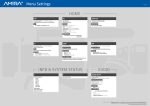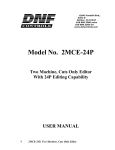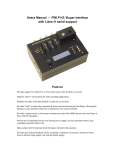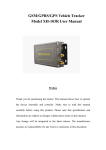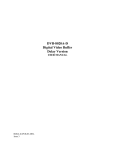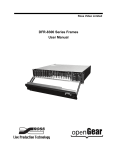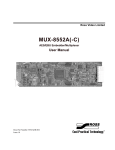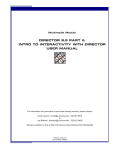Download View the preliminary user`s manual.
Transcript
The Kitchen Sync Versatile master sync generator and tester Preliminary User Manual The Kitchen Sync Preliminary User Manual Overview The Kitchen Sync is a small ( 5” x 4” x 1” ) unit that generates a variety of phase-accurate signals for synchronizing cameras, 3D rigs, and motion control systems together. This box generates all 17 of the hi-def video standards of SMPTE 269M / 274M. SMPTE Frame rate 720P 1080P (SMPTE 296M) (SMPTE 274M) 1080I (SMPTE 274M) 60.000 FPS √ 59.940 FPS √ 50.000 FPS √ 30.000 FPS √ √ √ ( 60.000 fields ) 29.976 FPS √ √ √ ( 59.940 fields ) 25.000 FPS √ √ √ ( 50.000 fields ) 24.000 FPS √ √ √ ( 48.000 fields ) 23.976 FPS √ √ √ ( 47.952 fields ) In addition, it generates a 50% square wave at any speed between 1.000 fps and 99.999 fps. The box also supports visual aids for checking adjusting sync and phase in the field without specialty tools like oscilloscopes and waveform monitors. Outputs: The Kitchen Sync has 5 outputs. All outputs are phase-accurate with each other. Tri-Level Sync: (2 ports) Standard 0.6V tri-level sync for most hi-def cameras operating at video rates. This output operates whenever a “valid” sync speed is selected. When an offspeed rate is specified, this output goes dark. HD-SDI Sync: (2 ports) Standard HD-SDI signal for hi-def cameras requiring a digital sync input. This output operates whenever a “valid” sync speed is selected. When an offspeed rate is specified, this output goes dark. 50% Square Wave: (2 ports) This TTL/LVTTL compatible output drives cameras which require a once-per frame signal, such as some specialty video cameras, many film cameras, and specialty interface devices such as “Barton Boxes” This output operates at all output speeds. If necessary, the voltage level on this output is selectable between 3.3V and 5.0 V via a jumper inside the box on the bottom of the board, however, since 3.3V is high enough to be a valid signal even in 5V systems, it can usually be left in the 3.3V position. Moco Sync: This TTL level output is intended to provide a 1PPF timing signal to motion control systems. This output operates at all output speeds. In order to keep the moco electronics and the video electronics from interfering with each other or generating ground loops, this output is electrically isolated from the rest of the box. Phase Clock: This output drives the dedicated phase clock display. This output operates at all output speeds. Inputs: Power: Apply 8 to 24VDC. Load is appx 190mA@ 8V, 110mA @ 24V. Controls and Indicators: Power LED: Does pretty much what every other power LED on Earth does. Output FPS: Selects the basic output frame rate, from 1.000 to 99.999FPS, in .001 frame increments. Basic accuracy, including oscillator drift, is +/- 3ppm from 0°c to 40°c, after a one-minute warm up. Video Format 3-postion slide switch which selects video format, 1080p, 1080i or 720p Moco Phase: Shifts the motion control phase relative to the other phase outputs, in order to better center the moco phase with the cameras. Each click is 1/10th of a cycle, or 36° Valid Video: This LED lights up to indicate that a valid video rate or multiple video rate has been selected. See below. Valid Video rates: Although the sync box will run at any rate from 1 to 99.999 fps, valid HD video is tightly defined and can only be generated at 5 specific rates from 23.976 to 30.000FPS for 1080 formats, and 8 specific rates from 23.976 to 60.000FPS for 720P format. When a valid video rate and format combination is selected, the Valid Rate LED lights up solid to indicate that the box is generating video sync at the selected frequency. Semi-Valid and Multiple Video rates: In addition to the basic video rates, there are situations where a valid video rate cannot be generated, but a video rate that is a multiple of the frame rate might be useful. For example, a common situation has an effects shot that uses a high-speed master camera, but incorporates several lower-speed witness cameras. It would be nice if everything can stay in phase, and at certain speeds, where all the rates are multiples of each other, this is possible. Say, for example, you have a master camera at 72FPS. The box can make a 72FPS square-wave, but cannot create a 72FPS video signal since no such thing exists. It will, however, search for a standard that is a multiple of the main rate, and generate that speed, if possible. In this case, all video formats support 24 fps, so the box will create a secondary video sync at 24FPS. When generating a multiple frame rate, the Valid Frame Rate LED will blink to indicate something is amiss. When the box can find no multiple speed, the video sync outputs will go dark. See appendix A for a list of Valid and semi-valid video rates Phase Clock The phase cock is a simple visual display of the running sync phase. It is a circle of 32 LED's, and as the phase progresses the LED's will rotate around the face of the clock, completing one revolution for each frame. A camera exposing for a shutter angle less than 360° will photograph less than 32 LED's. A camera with a shutter angle of 180°, for example will photograph an arc of only 16 LED's. The position of this arc will indicate where the camera exposure is happening relative to the video sync phase. You can tell if a camera is truly syncing to the input phase by temporarily “bumping” the sync speed a few fps, then going back to the set speed. When you bump the sync, a camera running wild will slowly drift out of phase. When the sync goes back on, the camera should return to the phase it was showing previously. In the case of a 3D system with two cameras, both cameras should show the exact same phase sector. Audio Sync The phase clock has a secondary function, it can be used to set audio delay timings. Typically on a film set, audio and video take two different processing paths. With the advent of digital video, many of the video processing electronics used on-set now add one or more frames of delay per box. This effect is especially pronounced with 3D systems which typically use many layers of processing to do flips and monitor packing. As a result, a significant audio/video skew can develop by the time both signals reach the video village. The phase clock can be used as a tool to determine this delay. In this application, flip the small select switch on the face of the clock from “phase” to “audio”. The clock will then start an automatic 1 second countdown sweep, flashing and beeping at exactly 12:00. Given these two synchronised events, the audio delay can then be set so that the sound and picture arrive at the monitors in-sync. Motion Control Sync In a Kuper motion control system, once camera sync has been established, the phase clock may used to establish moco phase. For this application, the motion control system is synchronized to the sync generator with the moco phase output, which is a once-per frame TTL pulse. The moco sync pulse is electrically isolated from the camera sync pulses and power supply. The phase clock is driven by the motion control with the moco interface box. In the Kuper, the user should determine a spare axis, and set it up to drive the interface box as though the box were a motor channel. Use 256 pulses per frame. You may have to experiment with direction to find out which way is forward (clockwise). Create a long move, say, 10,000 frames, and program a linear move to go exactly 1 unit per frame. ( In other words, the first keyframe is exactly 0,0, and the second keyframe is exactly 10000, 10000 ) Zero both the Kuper axis and interface box and run the move. (The phase clock will not run backwards during preroll The “zero” light on the front of the box will blink to warn you that the clock is not responding. The clock will “catch up” as soon as the move rolls forward and the phase goes through zero.) If the camera is photographing a shutter angle less than 360°, you will see a sector of LED's. With the Kuper phase angle set to its 180° default position, use the “moco phase adjust” switch on the sync generator to rotate the LED sector to center on 6:00. 6:00 is the center of the Kuper frame, and now corresponds to center shutter open. For more accuracy, you can then use the sync phase adjust in the Kuper to tweak the display to exactly 6:00. Appendix A: Valid frame rates, and Semi-Valid Multiple frame rates Master Selected Frame rate 720P 1080P 1080I SELECTED SELECTED SELECTED 96.000 frames/sec Generates 24.000 frames/sec Generates 24.000 frames/sec Generates 48.000 fields/sec 95.904 frames/sec Generates 23.976 frames/sec Generates 23.976 frames/sec Generates 47.952 fields/sec 75.000 frames/sec Generates 25.000 frames/sec Generates 25.000 frames/sec Generates 50.000 fields/sec 72.000 frames/sec Generates 24.000 frames/sec Generates 24.000 frames/sec Generates 48.000 fields/sec 71.928 frames/sec Generates 23.976 frames/sec Generates 23.976 frames/sec Generates 47.952 fields/sec 60.000 frames/sec √ Generates 30.000 frames/sec Generates 60.000 fields/sec 59.940 frames/sec √ Generates 29.970 frames/sec Generates 59.940 fields/sec 50.000 frames/sec √ Generates 25.000 frames/sec Generates 50.000 fields/sec 48.000 frames/sec Generates 24.000 frames/sec Generates 24.000 frames/sec Generates 48.000 fields/sec 47.952 frames/sec Generates 23.976 frames/sec Generates 23.976 frames/sec Generates 47.952 fields/sec 30.000 frames/sec √ √ √ ( 60.000 fields ) 29.976 frames/sec √ √ √ ( 59.940 fields ) 25.000 frames/sec √ √ √ ( 50.000 fields ) 24.000 frames/sec √ √ √ ( 48.000 fields ) 23.976 frames/sec √ √ √ ( 47.952 fields ) Note: The Valid Video LED will always light solid when the box is making an exact video frame rate... Will always blink when the box is making a sub-multiple video frame rate... Will always go out when the box cannot make a matching video signal, and the tri-level and SDI video outputs will go “dark”.










